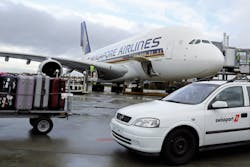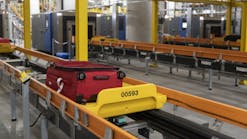Baggage Handling Developments In Europe
Recent forecasts from the International Air Transport Association predict that passenger numbers will grow by an average of just over 5.25 percent per year between 2012 and 2016 – culminating at around 3.6 billion passengers by the end of the period. With an anticipated 500 million or so new travelers set to fly on domestic routes, and a further 330 million fliers using international services, that all adds up to a lot of additional baggage too.
Mishandled baggage is already said to cost the industry an estimated $2.9 billion annually; add to this the growing emphasis on efficiency and improved passenger experience and the case for better baggage handling is clear. Not surprisingly, it has formed a compelling driver for a number of developments and innovations – and European airports have been quick to embrace the benefits that these new technologies can bring.
70 MILLION BAGS PROGRAM
Amsterdam Airport Schiphol in particular enjoys an enviable reputation for being swift to adopt novel approaches, and with the baggage handling upgrades and enhancements that have been implemented there over the last few years, it seems to be more than justified.
Schipol routinely deals with between 120,000 and 180,000 bags per day – a total of more than 55 million items a year; in the near future, that could rise to 70 million, if the airport’s intentions to expand its market share go according to plan. With the numbers due to rise – but the physical footprint set to remain the same – there are obvious gains to be made from increasing the operational efficiency of the baggage handling process, and the 70 Million Bags (70MB) program arose in response.
With a budget of around 800 million Euro, this massive infrastructure investment aims to provide the airport with the necessary capacity, reliability and quality of baggage handling service to support its ambitions to become the focus of increased air traffic, and Europe’s transfer hub of choice.
A major source of Schipol’s passenger volume comes from transfers, and transfer luggage accounts for around 40 percent of the baggage being handled in any one day – and that poses its own particular problems.
While maintaining the integrity of the chain of connection between passenger and bag is the essence of all baggage handling, the issue becomes orders of magnitude more complex for transfers, when items arriving on one aircraft must be consigned to any number of connecting flights, in limited time. To meet the challenge, the airport opted to go down the route of increased automation, chalking up a number of major "firsts" along the way.
BAGGAGE ON DEMAND
The "baggage on demand" – or "pull" – concept conceived by the airport was implemented by Grenzebach Automation and Vanderlande Industries and takes a batch approach, buffering bags in a central storage area and then using robots to load ramp-carts and containers automatically, as and when required.
Schipol began using a single robotic loader – the first installation of its kind in the world – in the summer of 2006, subsequently adding a further six in the airport’s new South Hall, which was officially taken into service in early 2011. In October of the same year, the system won the inaugural interTERMINAL innovation award at the inter airport Europe conference and trade show in Munich.
"All systems have been operationally in use since then, they work reliably, without any significant problems, and with excellent operational performance statistics," says Dr. Joachim Döhner, Grenzebach’s director of airport logistics.
RISE OF THE ROBOTS
Robots are making their mark at Germany’s largest airport, too. In 2013, Grenzebach installed one of its fully automated baggage loading systems at Frankfurt Airport, which processes 24 tons of baggage in each eight-hour shift, with loading staff now acting as system operators, not manual laborers.
Although the basic components are essentially the same as at Schipol, according to Grenzebach the key to making the robot loading system an individually tailored solution lies in the precise combination used, coupled with the full integration of the system into the conveying infrastructure and IT systems.
In addition, Frankfurt Airport has now also adopted a fully automated tub inspection line, which robotically cleans and examines the airport’s 20,000 baggage carriers, largely using optical measurements to pick up on any faults, and thus plays an important part in ensuring the baggage system runs reliably.
MUM
Automated solutions are increasingly featured at the other end of the journey, too, with the arrival of the likes of MUM (Mechanical Unloading Module) at Schipol as part of the 70MB program – a system described by some commentators as marking a huge leap forward in baggage handling technology.
Another world first, at its heart lies a mechanized system capable of lifting, tipping and emptying containers onto a conveyor for processing and sorting – and equipped with state-of-the-art video cameras to enable adjustments to be made as required.
Designed to improve worker safety and improve efficiency, MUM has already demonstrated a 10 percent increase in hourly throughput, and that is expected to increase further as the rest of the planned connecting systems and infrastructure come on line in the future.
SELF-SERVICE
It is not just behind the scenes, however, that the benefits of the improvement program can be seen; having pioneered a self-service approach to baggage drop-off in 2008, Schiphol has recently extended the idea in response to good reports from its users.
"Together with KLM, Schiphol introduced 12 self-service baggage drop-off units in Departure Hall 2 in January 2012," says airport spokesperson, Franciska Faber. "Because passengers and airlines were satisfied with the new service, we expanded the number of self-service baggage drop-off points: in the same year five units were introduced in Departure Hall 3 for easyJet and Arke-Fly. In December 2012 subsequently seven units were introduced in Departure Hall 1."
LOST BAGGAGE
The self-service approach has also started to gain traction in other ways too; in 2012, Swissport International, in collaboration with partner Sky Assist, linked the concept with e-services and introduced the first-ever self-reporting facility for lost baggage at Geneva International Airport.
Now, passengers missing bags on arrival can choose to enter the details online at a dedicated PC terminal, scanning their boarding pass to simplify much of the data entry, and adding the rest via a touch-screen – and so avoid the hassle and delay of conventional "Lost & Found" desks.
With all the necessary information given, the passenger receives a printout giving the appropriate contact details, an initial status report on the search, and when to expect the missing item to be returned.
The concept – now installed in dedicated kiosks in three other airports and scheduled to be added to more – seems to have gone over well with the travelers, as Roland Kühnelt, Swissport’s Head of Performance Management & Innovation, explains.
Bringing the self-service approach to lost baggage is the logical extension of the wider use of self-check ins and baggage drop-offs, and sits well with the general move within the industry to automate airport processes, and simplify the overall passenger experience.
"For our low-cost customer close to 90 percent of lost and found cases are handled via the online AHL declaration, for other customers the percentage is lower," says Roland Kühnelt, Swissport's head of performance management and innovation. "Feedback from passengers is generally positive, but we are always seeking to improve the service and make the declaration easier for them."
Swissport plans to extend this service to Helsinki-Vantaa Airport and in Spanish stations in due course.
FUTURE TRENDS
Despite the huge advances over recent years, it is clear that neither airports nor technology vendors seem intent on resting on their laurels just yet, with still more upgrades planned and new developments in the pipeline.
Grenzebach, for example, is working on integrating fully automated container transport in their solution, as well as adding further container types to their portfolio of supported loading units.
"We are also working on designing multi-destination loading cells – a loading cell which can support several containers for different destination simultaneously," Döhner says. "Beyond that, we continue to monitor evolution of 3D sensory technologies, which may help us to further enhance 3D resolution and implicitly positioning accuracy and loading quality."
For Swissport, in the near future Kühnelt says it will be focusing on improving its existing solutions – working on the likes of providing "web-to-mobile" boarding passes from its own Web check-in application, to be sent either via email or SMS. Home-printed luggage tags are another idea that the company is investigating, looking at how they can adapt their applications to produce them, while also keeping a close watch on the development of possible alternatives, such as permanent bag tags.
"In addition," Kühnelt says, "there are some very interesting ideas around what we could do, especially in terms of self-service for passengers, such as automatic bag drop or self-boarding gates. Most of these technologies are really useful to improve the passenger experience, by reducing queues and, therefore, the stress from passengers."
With these and other developments waiting in the wings, the industry looks to be shaping up well to meet the future, and all the luggage 3.6 billion fliers will bring.
About the author: Gareth Evans spent nearly twenty years developing and implementing commercial R&D, materials-handling, recycling and pollution control programmes, gaining experience across a range of industry sectors. He was also involved in a number of feasibility studies under the European Union’s 5th framework program and worked as a consultant on projects in the UK, Europe, Turkey and Australia.





